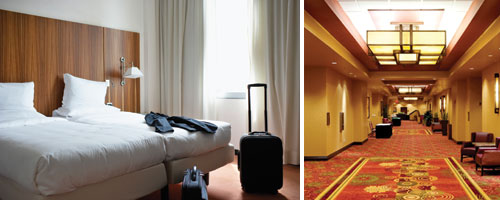Acoustical Control with Gypsum Board
SPECIFYING NOISE REDUCING GYPSUM BOARD
In writing specifications for noise reducing gypsum board, the first thing to determine is the needed sound rating for the assemblies incorporated into the building and design them accordingly, Then the following options can be considered.
- Thickness: 1/2" or 5/8" Type X
- Widths: 4'; Lengths: 8’ or custom
- Edges: Tapered
- Product Standards: ASTM C 1396, ASTM C 1629
 |
Noise reducing gypsum board is installed and finished in the same manner as conventional gypsum board. Photo courtesy of CertainTeed Gypsum |
Noise Reducing Gypsum Board is installed following traditional methods of application and finishing of interior gypsum board products for both walls and ceilings, but with a little more attention to detail to insure acoustic performance. First the board layout should be planned to stagger joints from one side of the wall to the other. Next, sound insulating fiberglass batts need to be installed in cavities for higher STC ratings where needed. Note that resilient channels are typically no longer needed to achieve performance except in very acoustically sensitive situations. It is appropriate to specify putty pads (tested per ASTM E 90) or acoustical sealant to seal electrical outlets, however.
Panels of noise reducing gypsum board should be installed in accordance with GA-216, “Application and Finishing of Gypsum Panels” (ASTM C 840) and the manufacturers’ application instructions. Best practices indicate to allow a 1/4" (6 mm) gap around all wall perimeter edges for any movement. Noise reducing gypsum boards are typically cut the same as other gypsum board by deeply scoring from both sides and snapping. Cutting across 4' width may require use of a hand or power saw. Specify to seal the 1/4" perimeter gaps and wall penetrations per ASTM C 919 with acoustical sealant.
Noise reducing gypsum board may be finished, painted or wallpapered using conventional gypsum board techniques. The Gypsum Association publication GA-214, “Recommended Levels of Gypsum Board Finish,” should be referenced when specifying the level of finishing desired.
CONCLUSION
Noise reducing gypsum board uses an innovative polymer layer that dampens sound energy when located between two gypsum boards with specially formulated, dense cores. These boards are enclosed in recycled moisture and mold resistant face and back papers that offer an economical single layer alternative to multi-layer gypsum board in wall and ceiling assemblies. The result of this combination is improved sound attenuation for high STC systems in a variety of building settings, distinct contributions to green building design, and direct contributions to compliance with emerging standards of acoustics as part of indoor environmental quality.
 |
Noise reducing gypsum board used in hospitality settings helps assure privacy and greater guest comfort. Photos courtesy of CertainTeed Gypsum |
 |
CertainTeed Gypsum offers a wide range of gypsum and finishing products for interior and exterior needs, providing architects, contractors, builders and dealers service and support for commercial and residential building projects. www.certainteed.com |








